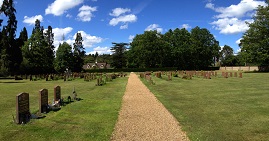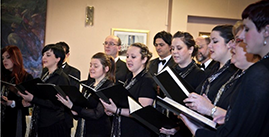Sunday of Orthodoxy 2015
Today we all gathered here to celebrate the Sunday of Orthodoxy; the feast that is also called the triumph of Orthodoxy.
We commemorate a historical event, when after a century long struggle the Church finally managed to convince its people that it is right for the faithful to venerate icons. The opponents of icons had been saying: "It is idolatry: you are venerating a created objects instead of the Creator". But by the grace of God that has always guided and enduringly guides our One, Holy, Catholic and Apostolic church, in the Synod of Constantinople decreed that the veneration icons is a good and God pleasing practice. On 11 March 843 which fell in that year on the first Sunday of Lent, the participants of the Synod and the jubilant crowd of the faithful made their way in a triumphal procession from the Church of Blachernae to Hagia Sophia, solemnly restoring the icons to their proper places in the Church. The anniversary of that day should has been observed each year on the First Sunday of Great Lent, and named the day, "the Sunday of Orthodoxy". By the Divine intuition the Church discerned in this, apparently insignificant, perhaps even local event a landmark of universal importance.
For some people, Christians of other confessions especially, icons may seem insignificant: "It is no big deal, ¬– they may say, – ¬whether you venerate icons or not – it doesn't really matter: they are not a part of your relationship with the most High God, who would not be bothered with such tiny details".
"No, - says the Orthodox Church, – It means a great deal, and it DOES matter, and it matters much". And the magnitude of today's celebration is a mighty testimony to this. It puts a final stamp of authenticity upon the whole truth of Christianity: "God became flesh". "The Immaterial God became material, visible, tangible". It may sound surprising, but the main issue of the iconoclast controversy was not about icons as such, it was about the presence of God in the world, it was about the character of God, about His love: Does He really love the world as He claims? Is He really incarnate in the world with us, as He said: "I AM with you! Always!" even after his ascension? Can we really confess Him as Emmanuel (as Christ was named at his birth). This name means "God is with us"?
The veneration of icons per se is a powerful answer to all these questions. As if an icon silently says to us: "Yes God is with us. God did become flesh. We icons are witness to and continuation of His incarnation. God is in full communion with His created material world. He has not forsaken, neither you nor the world, because God is Love that you, men, can trust".
Through our personal liturgical experience we know that icons are not simply pictures they are sacred images, filled with God's grace. They convey to us the presence of the Holy Persons that they depict.
I remember when I was as a child in the Soviet Russia, sometimes I had to accompany my mum on rather boring excursions to monasteries and churches that the Soviet authorities turned into mere architectural and cultural monuments. Once we entered a church building. There was nothing inside but blank walls and the altar. I remember telling my mum naively: "Mummy, it doesn't look like a church to me. Where is God? It's not His home! Has He changed His address?". What I meant was that there were no icons of Christ and saints, which I used to see in temples where church services still took place.
We take it for granted when we enter our Orthodox Churches that the whole space is almost tangibly filled with the presence of God and His saints. And this is largely due to the Holy Icons. They are not only a symbolic sign but also our very experience of the presence of God. And today by celebrating the Restoration of icons we triumphantly celebrate, confess, and reaffirm the presence of God. The restoration of His Kingdom here on earth.
This is our feast today!
But God is present not only in our Churches. Icons bring God into our homes, into our lives and even into our environment. If you travel around any orthodox country especially Greece you will see here and there icons and proseuchitaria – small prayer shrines. A wonderful cohabitation of men and saints! When I read the life of St Matrona of Moscow, I was struck by her saying: "Before, when icons used to be in every home, people lived together with God and the saints, but now, BECAUSE of the absence of icons the houses are inhabited by powers of a different kind, and these enter the minds and hearts of men". Indeed, when we don't see icons around us in the modern unbelieving world, questions naturally start to creep into our minds: "Where is God?", "He seems to be so distant, he doesn't care for us". "Who is He – a distant observer, who looks down on our lives as a remote spectator? How could He allow this nightmare? The whole world is steeped in suffering, in darkness, in despair". But with our beloved icons, the guardians of our faith we, Orthodox Christians, see the world differently. When an icon of God is on our walls, we don't have such questions: we are busy with the life in God that is our continual feast and celebration of His presence, life of thanksgiving to God for His abundant gifts of life. And the greater your faith in God the greater is the joy of this celebration. Once Christ said to the Canaanite woman: "Let it be according to your faith'. Indeed, if we don't believe, even icons become simple pictures, works of art . But if we believe they come to life. If we don't believe, we won't see. If we don't knock, it shall not be opened. If we don't seek, we shall not find. If we continue with our secular life without God, God will continue with His heavenly life without us. If people ask "Why hasn't He come into my life?", He will answer: "Why haven't you let me in?". In the Revelation Christ says: "Behold, I stand at the door, and knock: if any man hear my voice, and open the door, I will come in to him" (Rev. 3:20). Indeed, if we do open the doors to Him, God enters our lives mightily, wonderfully, and gloriously! Or rather it is we who start to see and to feel His presence, hitherto hidden from our mind, blinded by our primitive human logic. Our faith opens our eyes to see that God "is everywhere present and fills all things" as we say in our prayer. The more you believe, the more you see... It is then that the whole world becomes for us a living icon the dwelling place of God. Behind all that happens to us in this world we discern the loving hand of God: in good times and in times of troubles, in our wealth and in our poverty, in our successes and in our failures, in our strength and in our weakness, in our wholeness and in our brokenness, in whatever may come – "God is all in all", for those who believe. God is called Pantocrator, Вседержитель – that means „He Who holds everything", holds everything under control. That means every minute detail and every happening in our life – all are enclosed in His caring providence that guides us to the fullness of life, to our true happiness. So his very name expresses His total presence in our life.
As we celebrate today this presence, I remember a story of a hermit from Mt Athos. He said: "When I lived in the desert, where only God can provide for your needs, I started to see more and more how God cares for us. God provided me with excellent 24x7 service for my daily needs. He proved to me how true is His every promise, when he said – "don't be anxious about tomorrow I will take care of what you shall eat, of clothes for your body, of where you will dwell... even the hair of your head are counted". I lived profoundly the bliss of the words that we pray at the end of our ektenies: "Let us entrust ourselves, one another and our whole life to Christ our God". With confidence! I did it and I found eternal rest in God here on earth. His tender care for me melted my heart into love for Him. I said to Him: I know you are here, and you don't even give me a chance for faith. Your presence is no longer a matter of faith, it is a fact of my life".
Today I am grateful to bear witness that no other Christian confession, no other mainstream monotheistic religion confesses and lives the presence of God in the world and in our lives, as does Orthodoxy. There is an interesting convergence: those Christian confessions that oppose the veneration of icons, as contrary to their principle "sola fide: "by faith alone", arrive at rather peculiar theologies that proclaim an absent God, or a hidden God (Deus Abscondus), a silent God, or even a dead God. They have tried on and on every sophisticated logical arrangement and rearrangement, to justify their deficiency in the experience of God. Icons save us from these theological wonderings. For us Orthodox, Christ is an utterly tangible part of our life, just as the icons are tangible. We can touch them, just as we touch and partake of the Body of Christ in the sacrament of communion. In this sense the icons have also profound liturgical meaning: they prepare us in faith to believe in the Holy Sacraments. If you don't see trough visible icons their invisible prototype, how can you see the Body and Blood in bread and wine? That is why those confessions that deny icons naturally end up with denial of sacraments. It won't happen to us, until we have the iconostasis in our churches: it looks this holy army of depicted saints shield and guard the altar, the Holy of Holies, where the ultimate sacrament of faith takes place: bread and wine become the Body and Blood of Christ. The icons on the iconostasis act like custodians of our faith in this sacrament, as if you cannot approach the Body and Blood of Christ without passing through faith check points of the icons; who are like officers of the passport control at the borders of the Heavenly Kingdom, to where Eucharist leads us.
But above all icons are the promise of our own deification, of our potential to become living icons of Christ. In our deification lies the whole mystery of our salvation, and icons inspire us to this wonderful exploit, as if they challenge us to compete with them: saying silently: "If even we – irrational wood and colours – can become God's images, how unforgivable it is for you, men, who are created as his image, to fail in this task – of becoming His living icon!".
Icons are holy, because they bear the image of the Holy. If God readily grants this privilege to wood and colors, how much holier should we be ¬– His supreme Image and Likeness, His Ultimate Icon! Christ showed us the way by His example and by His commandments: "If you keep my commandments I will come with my Father and dwell in you". And you will become a living icon of the Eternal God forever, unto the ages of ages.
Together with St John the Theologian we say: "Yes, Lord COME" ... "May thy grace (of our God and Saviour, Jesus Christ), and may thy Love (of God the Father), and may thy communion (of the Holy Ghost) be with us and in us all, unto the ages of ages.
Amin.






